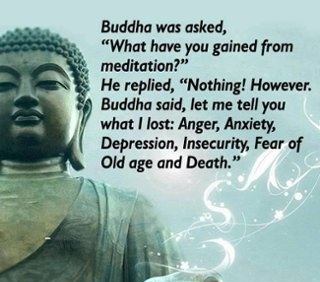![]()
When people ask me what is Meditation? I often answer that its an art of happiness, an art of celebration. Meditation is just being delighted in your own presence; meditation is a delight in your own being. It is very simple – a totally relaxed state of consciousness or awareness where you are celebrating and happy for not doing anything. The festive or joyous dimension of the total existence of one being can be called as mediation. Meditation is just to be, not doing anything – no action, no thought, no emotion. You just are. Just celebration and it is a sheer delight. To read more on Meditation click on the link below: https://thepositivediary.com/meditation-the-art-of-celebration/
Techniques of Meditation:
And there have been various methods derived for meditation. In Western tradition, meditation is linked to a personal relationship with God. Asiatic meditation places more emphasis on techniques. While the Western form of meditation has traditionally been based on content, technical forms of meditation are far more widespread in Asia. A typical example of a content-based form of meditation is the recitation of prayers or scripture. It can also be the visualization of specific episodes or incidents — like a story from sacred scripture, the death of Christ or one’s own death. Such meditation practices have been used in Christianity, Judaism and Islam which are the prominent religions in the West.
There are similar forms of meditation in the Asiatic tradition, but these often emphasize a technical tradition. The technical tradition can also be based on either recitation or visualization. But typically this form of meditation tends to involve reciting sounds without content or visualizing things like geometrical figures. Like In Hinduism the sound of Om is often used for recitation and symbol of Swastika is used on multiple occasion. Technical forms of meditation can also be more physical and focus on breathing techniques and movements — as in yoga.
The West and the East
One of the reasons for the difference between Asiatic and Western meditation is that the Western religions place far more emphasis on a personal relationship with God.This personal relationship is not as important in Asiatic meditation. But in-spite of all different methods , two of them are my favourites. The first being the Dervish Whirling practiced in Sufism. The second being, and the best one according to me is the Koan impossible puzzles practiced by Zen -The Buddhist.
Zen have a special method of meditation. They call it Koan or Ko-an. A koan is a puzzle. But its not like an ordinary puzzle. Ordinary puzzle can be solved, they are meant to be solved. They might be difficult but they are not impossible. But a Koan is an impossible puzzle. You cannot solve it and there is no way to solve it. They are meant to focus the mind on the central questions of Zen by creating “great doubt”. There is no right and no wrong answer.
I came to know about this method for the first time during my visit to Vietnam. I was being accompanied by my colleague Catherine and her son David when we met one of the Zen master. In our first meet itself, after a little brief about it; he asked us three Koans. On listening to them we were surely lost in the first instance. And massively insulted for our multiple wrong attempts as Koans don’t have any right attempt. Koan is an impossible puzzle. But a 7- year old David helped us find the answers. So let me share the 3 Koans and the idea behind it.
The First one was:
What is the sound of one hand clapping?
On hearing this we were totally crazy and what not thoughts ran through our mind. After a bit of Havoc created and with no help to find its answer, i thought to surrender. I went to David for a bit of play while her mother was still giving a thought on an Impossible Koan puzzle. In a funny way just asked the question to David, can you hear the sound of one hand clapping. To my surprise he heard the question and started acting on it. He clapped with 2 and heard the sound and laughed. Then he kept his one hand away and tried the act only with one hand and laughed again.
I thought he is ignorant and immature and simply crazy to laugh on it. But after 2-3 repeated attempts and seeing him laughing made me more curious. I tried myself and experienced the silence as there was no sound of a hand clapping. But when it was tried from within this silence was experienced within. The sound of Silence was felt. The emptiness was felt and there was a delight and a smile on the face. And I found the answer the emptiness within. The question or the answer was a device but there was a Silence within.
This excited us to try the second Koan and here it goes.
One day Chao-chou fell down in the snow, and called out, “Help me up! Help me up!” A monk came and lay down beside him. Chao-chou got up and went away.
With an experience of first and figuring that the action might help; Me and David stimulated the second one too. I sat on the roadside and asked David to help to lift me up. But he being a small kid instead of lifting me also eventually fell beside me and looked helpless but started laughing on the fall. I looked at him, he looked at me and we both got up again on our own. But while getting up there was a thought that you are alone and you are the only one that can help self to get up. With this thought there was an experience of emptiness in the surround. With this emptiness originating from being helpless;there was an experience of loneliness and Silence in the surrounding. Weird but the Loneliness and the Silence was common. Our eyes glowed to experience something new. It was the Silence.
With this idea we read the Third question which read as :
Nan-in served tea. He poured his visitor’s cup full, and then kept on pouring. The professor watched the overflow until he no longer could restrain himself. “It is overfull. No more will go in!”
“Like this cup,” Nan-in said, “you are full of your own opinions and speculations. How can I show you Zen unless you first empty your cup?”
And while reading this it was again the Emptiness that was being given the emphasis on. It was the Silence the Zen were all about. It was the Silence the Koans were all about. There was nothing about the Questions or the Answers as said before Koan cant be answered. Nor can they be solved.Koan is an impossible puzzle.But they are only the device who can make you feel That Emptiness and That Silence. That Silence which is the starting step to find yourself, the deep insight. The device to Meditate with Silence. We eventually entered the room with a delight and seeing this the Master asked us “Did you find the answer of any?” We three with our happy faces looked at each other and then to the Master and he looked at us with a smile and simply all four of us shared guess what- Only THE SILENCE.
Akshay Kothari… Silence spoken.
Refer to the Link to have a visual about Zen koans- The impossible Puzzle : https://www.youtube.com/watch?v=9p5Oi4wPVVo








Silence!
What a way to explain its value!
nice thoughts
Nice
Very well said!
You have written it even has explained in such a good manner👏🏻
Well done Akshay & keep it up👍🏻
Very well said!
Keep writing & posting such kind of positive posts👍🏻👏🏻
Even nice thoughts
Creativity happens slowly in silence,its the destruction which makes noise. Don’t believe me; watch a flower blossoming and see a tree falling down. Mediation is okay, chanting is okay, everything is okay but what follows once you are sone with all this, is what persists and “that’s silence” that’s the catch….isnt it.